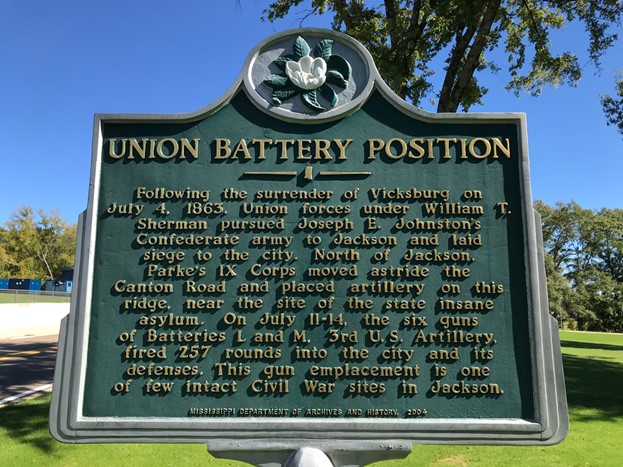Tours
Civil War Union Artillery Battery

Photo courtesy of Brother Rogers and the MDAH
"Following the surrender of Vicksburg on July 4, 1863, Union forces under William T. Sherman pursued Joseph E. Johnston's Confederate army to Jackson and laid siege to the city. North of Jackson, Parke's IX Corps moved astride the Canton Road and placed artillery on this ridge, near the site of the state insane asylum. On July 11-14, the six guns of Batteries L and M, 3rd U.S. Artillery, fired 257 rounds into the city and its defenses. This gun emplacement is one of few intact Civil War sites in Jackson."
Marker inscription from the MDAH, 1978 (date of marker installation)
The Siege of Jackson
The Siege of Jackson, Mississippi, from July 9 to July 16, 1863, was a significant operation during the Civil War. Thousands of the approximately 50,000 Union troops that encircled the city of Jackson traversed the area now occupied by UMMC and established their encampment on what was then the Mississippi State Lunatic Asylum grounds. The Siege followed the Union victory at Vicksburg and aimed to eliminate Jackson as a Confederate stronghold. This siege was part of Union General Ulysses S. Grant's Vicksburg Campaign, executed by General William T. Sherman, who led approximately 50,000 Union troops against Confederate General Joseph E. Johnston and his force of about 32,000.
Background
After the surrender of Vicksburg on July 4, 1863, Sherman pursued Johnston, who had retreated to Jackson. Johnston fortified the city, which served as Mississippi's capital and an important Confederate supply and railroad hub. Jackson's defenses consisted of earthworks and artillery, but Johnston faced challenges, including limited supplies and Union numerical superiority.
Encirclement and Bombardment
By July 10, Sherman's forces encircled Jackson, cutting off its supply routes. The Union army began bombarding the city, firing over 200 artillery rounds daily to weaken Confederate defenses.
Union Assaults
On July 12, Brigadier General Jacob Lauman’s Union division launched a direct assault on Confederate defenses but was repelled with heavy casualties, losing over 500 men. This failure shifted Sherman’s strategy back to siege tactics.
Confederate Resistance
Johnston attempted countermeasures, including using cavalry to disrupt Union supply lines. However, these efforts failed, and Confederate morale and resources continued to dwindle.
Evacuation
On the night of July 16, Johnston evacuated Jackson under the cover of darkness, retreating across the Pearl River to Morton, Mississippi. The Confederates destroyed supplies they could not carry, leaving Jackson open for Union occupation.
Aftermath
Sherman’s forces entered Jackson on July 17, destroying key infrastructure, including railroads, factories, and military facilities, to prevent the city from supporting the Confederate war effort. The siege was a Union victory, further crippling the Confederate position in the Mississippi theater.
Significance
The siege, coupled with the fall of Vicksburg, was a devastating blow to Confederate morale and logistics.
- Jackson was left in ruins, earning it the nickname "Chimneyville" due to the widespread destruction.
- The Union solidified its control over the Mississippi River and central Mississippi, further dividing the Confederacy.
The Siege of Jackson demonstrated the Union's effective use of combined arms and logistical dominance to subdue Confederate resistance.
"History Is Lunch: The Civil War Siege of Jackson, Mississippi" video from MDAH
The Civil War Siege of Jackson Mississippi by Jim Woodrick from Lemuria Books


